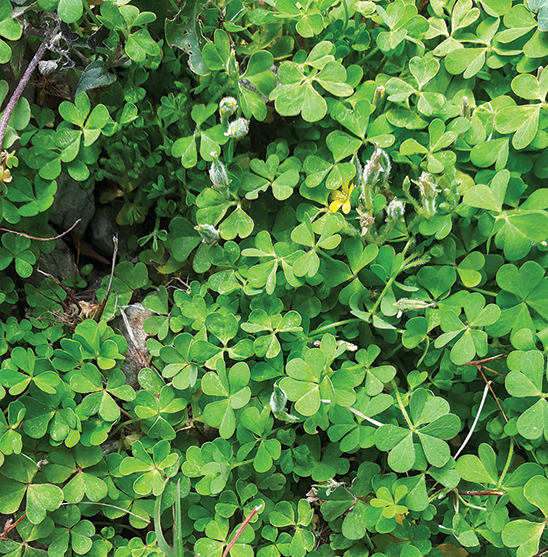Changeri (Oxalis corniculata)
This herb is known as tinpatia in Hindi and Indian sorrel in English. It belongs to family Oxiladaceae and Changeri kula in Ayurveda. This herbaceous plant is widely naturalized and its original habitat is obscure. It is considered a cosmopolitan weed of tropical and temperate zones and probably occurs in most countries in the world. It occurs in gardens, lawns, arable land and pastures.
Plant Description: This plant is perennial with a slender primary root. Stems are prostrate about 40 cm long, slender, weak, branched, often rooting at nodes, covered with spreading flexible hairs. Leaves have 3 leaflets, alternate, sometimes appearing almost whorled on short lateral stems, green or purple and are arranged alternately along the stems. A single long stalk arises from the axils of the leaf, from which extend 3 flower stalks, each with a single flower. The flowers are 7-11 mm wide and have 5 yellow petals. The fruit is a capsule. Seeds are many, minute, broad-ellipsoid, dark purplish brown. The leaves can be used raw or cooked, added to salads, cooked as a potherb with other, milder flavored greens or used to give a sour flavor to other foods.
Ayurvedic Pharmacology: Rasa- Amla, Kashay Guna- Laghu, Ruksha Veerya- Ushna Vipaak- Amla
Chemical Composition: The leaves contain oxalic acid, which gives them their sharp sour flavor. It also contains potassium.
Therapeutically Useful Parts: Whole plant.
Dose: Juice- 5 to 10 ml.
Therapeutic Uses: It is used in kaphavaata imbalances. Externally used in skin ulcers and to treat headache. Internally used for loss of appetite, indigestion, piles, dysentery, diarrhoea, prolapse of rectum, bleeding disorders, fevers and datura poisoning. Das et al. (2012) tested the possible heptaprotective activity of extracts on rats and found that they seemed to show dose dependent reduction of necrosis induced by thioacetamide.
Precaution: Though the herb is all right in small quantities, the leaves should not be eaten in large amounts since oxalic acid can bind up calcium leading to it’s deficiency. The quantity of oxalic acid reduces if the leaves are cooked. People with a tendency to rheumatism, arthritis, gout, kidney stones or hyperacidity should take precaution if including this plant in their diet since it can aggravate their condition.
Dr. Pratibha Mamgain, Dept. of Ayurvedic Medicine

